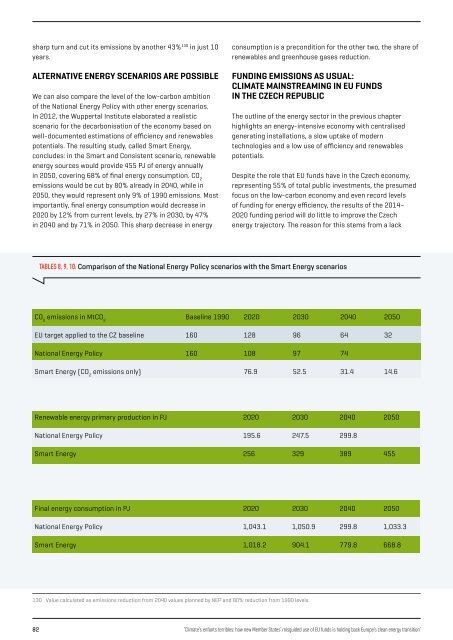ENFANTS TERRIBLES
enfants-terribles
enfants-terribles
Create successful ePaper yourself
Turn your PDF publications into a flip-book with our unique Google optimized e-Paper software.
sharp turn and cut its emissions by another 43% 130 in just 10<br />
years.<br />
ALTERNATIVE ENERGY SCENARIOS ARE POSSIBLE<br />
We can also compare the level of the low-carbon ambition<br />
of the National Energy Policy with other energy scenarios.<br />
In 2012, the Wuppertal Institute elaborated a realistic<br />
scenario for the decarbonisation of the economy based on<br />
well-documented estimations of efficiency and renewables<br />
potentials. The resulting study, called Smart Energy,<br />
concludes: in the Smart and Consistent scenario, renewable<br />
energy sources would provide 455 PJ of energy annually<br />
in 2050, covering 68% of final energy consumption. CO 2<br />
emissions would be cut by 80% already in 2040, while in<br />
2050, they would represent only 9% of 1990 emissions. Most<br />
importantly, final energy consumption would decrease in<br />
2020 by 12% from current levels, by 27% in 2030, by 47%<br />
in 2040 and by 71% in 2050. This sharp decrease in energy<br />
consumption is a precondition for the other two, the share of<br />
renewables and greenhouse gases reduction.<br />
FUNDING EMISSIONS AS USUAL:<br />
CLIMATE MAINSTREAMING IN EU FUNDS<br />
IN THE CZECH REPUBLIC<br />
The outline of the energy sector in the previous chapter<br />
highlights an energy-intensive economy with centralised<br />
generating installations, a slow uptake of modern<br />
technologies and a low use of efficiency and renewables<br />
potentials.<br />
Despite the role that EU funds have in the Czech economy,<br />
representing 55% of total public investments, the presumed<br />
focus on the low-carbon economy and even record levels<br />
of funding for energy efficiency, the results of the 2014–<br />
2020 funding period will do little to improve the Czech<br />
energy trajectory. The reason for this stems from a lack<br />
TABLES 8, 9, 10: Comparison of the National Energy Policy scenarios with the Smart Energy scenarios<br />
CO 2<br />
emissions in MtCO 2<br />
Baseline 1990 2020 2030 2040 2050<br />
EU target applied to the CZ baseline 160 128 96 64 32<br />
National Energy Policy 160 108 97 74<br />
Smart Energy (CO 2<br />
emissions only) 76.9 52.5 31.4 14.6<br />
Renewable energy primary production in PJ 2020 2030 2040 2050<br />
National Energy Policy 195.6 247.5 299.8<br />
Smart Energy 256 329 389 455<br />
Final energy consumption in PJ 2020 2030 2040 2050<br />
National Energy Policy 1,043.1 1,050.9 299.8 1,033.3<br />
Smart Energy 1,018.2 904.1 779.8 668.8<br />
130<br />
Value calculated as emissions reduction from 2040 values planned by NEP and 80% reduction from 1990 levels.<br />
82<br />
‘Climate’s enfants terribles: how new Member States’ misguided use of EU funds is holding back Europe’s clean energy transition’


